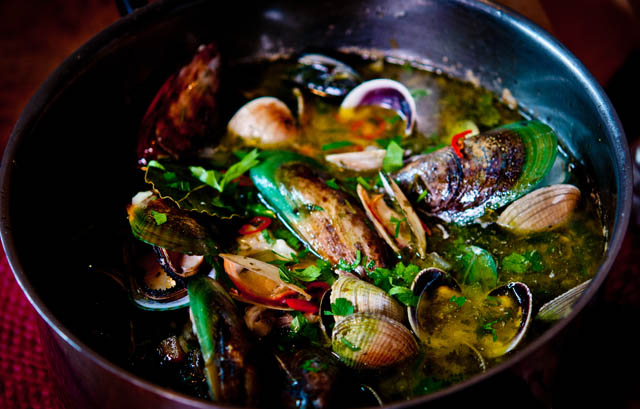These are the notes I hand out at my inpatient liver presentations.
They do not promote carbohydrate restriction because they are aimed at people with alcohol and drug issues who more often than not need to eat more of (almost) everything. Nor do they include supplements, as supplementation is decided on a case-by-case issue for inpatients.
Apart from that, it includes everything I had learned about a year ago...
EATING for a HEALTHY LIVER:with regard to RECOVERY from ALCOHOL AND OTHER DRUG ABUSE and HEPATITIS C
The type of diet, and the specific foods you eat, can play a large
role in recovery from liver damage. A few substances found in common
foods can promote liver fibrosis; many specific foods have been shown,
or are suspected, to prevent it.
In general terms
1) Protein is very protective of the liver,
2) Complex carbohydrate (starch) is protective but simple (sweet)
sugars can be harmful, and
3) Saturated fat is protective, while polyunsaturated fat can be harmful.
There are 3 specific substances to minimize or avoid:
Minimize:
Fructose (found in sugar, corn syrup, fruit juice concentrate, agave
juice, honey, as well as sweet fruit).
Fructose is directly converted to fat in the liver and reduces the
insulin response to glucose; high consumption of fructose can cause
fatty liver, type 2 diabetes, gout and irritable bowel syndrome.
Whole fruit and dark honey, in limited amounts, are safe sources of
fructose for most people.
(In the Hepatitis C Virus (HCV) life cycle, fructose induces DGAT1 and
promotes VLDL expression, increasing the release of virus to the
bloodstream).
Minimize:
Polyunsaturated fats; PUFAs (from vegetable oils and non-dairy
spreads). These fats are essential only in such amounts as one might
easily obtain from a diet containing meat, dairy, eggs, and fish, with
occasional nuts and seeds. Vegetable oils contain large quantities of
omega-6 lineolic acid, which promotes inflammation and suppresses
omega-3 fats.
The popularity of omega-3 fish oil in modern times is due to the
excessive amount of omega-6 in food oils and processed foods.
When large amounts of polyunsaturated fats are added to alcohol or
drugs, liver damage and fibrosis are increased.
Persons with Hepatitis C show increased fibrosis and worse responses
to treatment with higher PUFA content of the diet.
Vegetable oils decrease LDL and HDL cholesterol, while saturated
animal fats increase both. In persons with Hep C, higher LDL and total
cholesterol is associated with a lower degree of fibrosis and a better
response to treatment.
(In the HCV life cycle, low LDL causes an increase in LDL-receptors,
which are used by the virus to infect new cells).
The fat from pork and poultry is relatively high in omega-6 PUFA, and
is not protective, whereas fat from beef, lamb, goat, venison, dairy,
cocoa, and coconut is protective.
Minimize, and if possible Avoid:
Gluten grains.
Wheat (flour, bread, pastry etc.), Rye, Barley, Spelt, Kamut, Oats.
These grains contain glutenin and gliadin (proteins), together with
agglutinating lectins, phytates, and fructose-containing fibre (FOS),
which can damage the gut when consumed in the excessive amounts found
in the modern diet (it’s not just the gluten that’s harmful in these
foods). Whole grains contain more agglutinin lectins, phytates, and
FOS than white flour, which is however lacking in most vitamins and
contains added iron.
Gluten grains cause “leaky gut” (increased intestinal permeability)
which allows bacteria and toxic undigested proteins to enter the
bloodstream from the gut.
Parts of these bacteria called LPS can trigger inflammation in the
Liver.
Persons with Hepatitis C have an increased rate of Coeliac disease, a
gluten sensitivity disease. Coeliac and non-celiac gluten sensitivity
can cause liver cirrhosis, gall bladder disease, and diabetes (types 1
and 2), as well as most of the autoimmune diseases common in people
with Hepatitis C.
Humans have been eating grains for a relatively short period of our
history and have not had time to adapt properly to a food that poses
so many digestive challenges.
Grains supply no nutrients not found in other foods; meat, eggs,
dairy, nuts and seeds are better sources of protein, vitamins and
essential fats, while root vegetables and tubers are better sources of
starches, and green vegetables are richer in protective
phytochemicals. White rice, quinoa, buckwheat, millet are non-gluten
grains that are tolerated by most people. Some people who do not
tolerate other gluten grains can tolerate oats in small amounts.
Some special foods that protect the liver:
Beef consumption is related to lower rates of cirrhosis, and this is
probably true for all red meats. The same is true for eggs. However
pork and processed meats (which are mainly pork) may increase
cirrhosis. Red meats are best.
Spices, including turmeric, fenugreek, saffron, garlic, vanilla are
protective against fibrosis.
Coffee consumption protects against fibrosis and cirrhosis from
alcohol and possibly Hepatitis C. Green tea (and possibly black tea)
protects against fibrosis, but this effect may be reduced by milk in
tea.
DHA from oily fish is protective against fibrosis in moderate
supplement doses but may increase it in excessive amounts.
Lecithin, betaine and choline protect against fatty liver; these are
found in eggs, chocolate, liver and kidney, and fish roe (lecithin and
choline), and in beetroot and spinach (betaine).
Beetroot contains betaine and some unusual and potent antioxidants,
betalains, which are destroyed by cooking (boil beetroot for less than
15 minutes, roast for under 1 hour).
Vitamins A and K2 protect against liver cancer and are found in animal
fat, organ meats, fermented dairy foods, and (K2 only) spirulina and
fermented soy.
Brazil nuts are the richest source of selenium, which also protects
against liver cancer and fibrosis. Each nut contains 19mcg selenium; 4
a day is enough. Meat and seafood are also good sources of selenium.
Carotenoids, folic acid, and flavonoids protect against fibrosis and
are found in green leafy vegetables; sulfur compounds found in
cruciferous veges (cabbage, broccoli, mustard, radish etc.) stimulate
immunity and protect against cancers.
OPCS, astringent polyphenols found in grape seed, pine bark, cocoa,
berries, and apples, protect the circulation of the liver, and protect
against the blood cancers (lymphoma) associated with both Hepatitis C
and coeliac disease.
Chinese mushrooms such as shiitake, black and white fungus, etc.
(dried or fresh) have benefits for the liver and immune system.
Eat FOOD: don’t eat food products. If possible cook it yourself or eat it raw.
These canned foods are good: sardines, tuna, mackerel: tomatoes,
beans, beetroot: olives; and bottled (not canned) pasta sauces. Frozen
vegetables and berries are excellent foods. Prunes and raisins are
good dried fruits.
MTR boil-in-a-bag curries are good occasional convenience foods.
Try to avoid processed meats, pure beef or venison sausages are the
best varieties.
It is not necessary to try to eat all the special foods. These are
good if you have them and like them, but you will not die from their
lack.
Eat some red meat, eggs, and occasional fish; some dairy (especially
butter, cream, yoghurt, or aged cheese) if this suits you; some
starchy vegetables (potato, kumara, carrot, swede, yam, beetroot,
peas, etc.); some green vegetables - raw or cooked (spinach, cabbage,
cauliflower, celery, lettuce, etc,); and some fruit or berries. Use
spices, onion, garlic, extra virgin olive oil, or herbs for
flavouring. Eat fresh nuts and seeds in moderation if you like. Enjoy
dark chocolate, coffee, tea, herb tea, fruit tea, as far as possible
unsweetened (cream can be a good substitute for sugar in coffee and
cocoa). Drink clean water regularly. Do not overdose on “fibre”.
Cook food at lower temperatures (below 200C in the oven; 170C is good
for roasting most things), remember water in a dish (as with soups and
casseroles) helps to control temperature, and fry and roast with
traditional fats, especially beef and lamb dripping, or butter and
ghee. If a meal needs oil use extra-virgin olive oil. Pan-roast chips
rather than deep-frying.
Some references:
Dietary Fat and Alcoholic Liver Disease; a concise review. Esteban Mezey
Alcohol and dietary intake in the development of chronic pancreatitis
and liver disease in alcoholism. E Mezey, et al.
Fructose, PUFA and Gluten papers linked to Hyperlipid blog (use blog
search function)
Gluten Grains, Carbohydrates and Fats sections of Archevore blog (ditto)
Beef fat Prevents Alcoholic Liver Disease in the Rat; Nanji et al.
Relationship between Dietary Beef, Fat, and Pork and Alcoholic
Cirrhosis; Bridges
Dangerous Grains; book by Hogan and Braley.
Life Extension Foundation website: Health Concern: Hepatitis C (for
advice on supplements and drugs)
Applying principles of HCV virology to the Development of new
Antiviral Therapies; Stephen J. Polyak
(c) George D Henderson 2012
Feel free to use this.
A video of my 2009 working holiday in New Zealand's scenic Southern Alps. Music: Walrus Arabia, by The Puddle. I'm the one with the moustache and the guitar, Gavin wears the hat and the bass, and my brother Ian was behind the camera, the drumkit, and the steering wheel.



















